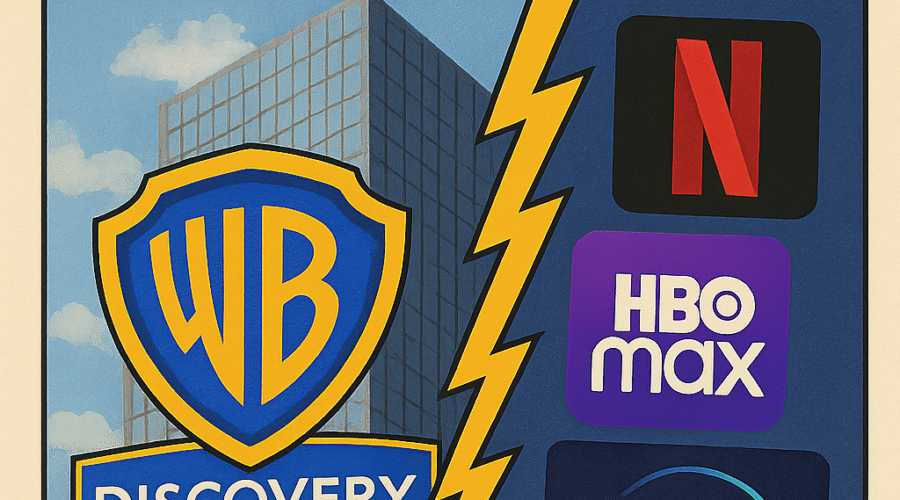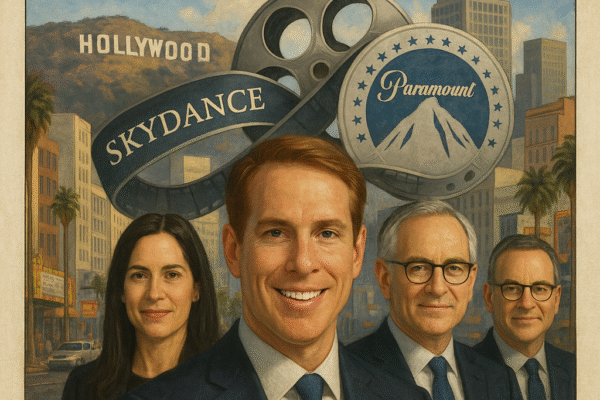Warner Bros. Discovery (WBD) is executing one of the most consequential corporate restructurings in modern media history, separating its declining linear cable networks from its high-growth streaming and studio operations. This tectonic shift—set for completion by mid-2025—comes as the $38 billion debt-laden conglomerate confronts collapsing cable revenues (-7% YoY in Q1 2025) against streaming subscriber growth (+5.3 million in Q1). The split creates two distinct entities: Global Linear Networks (CNN, HGTV, TNT Sports) focused on cash preservation, and Streaming & Studios (Max, Warner Bros. Pictures) targeting content-driven expansion. While investors initially cheered the move (15% stock surge post-announcement), the long-term viability hinges on Zaslav’s ability to monetize fading cable assets while scaling streaming profitability in an increasingly fragmented market[1][5][9][18].
Strategic Rationale: The Great Unbundling
Linear Networks: Managing the Decline
The Global Linear Networks division inherits WBD’s cable portfolio—including CNN, Food Network, and TLC—which generated $4.8 billion in Q1 2025 (-7% YoY). With U.S. pay-TV households projected to fall below 50 million by 2026, this segment faces existential pressures: advertising revenue dropped 8% ex-FX in Q1, while distribution fees slipped 1% despite streaming gains[18]. The restructuring allows WBD to isolate these assets for potential divestiture, mirroring Comcast’s creation of “SpinCo” for NBCUniversal’s cable networks[1][4][14]. Deutsche Bank analysts estimate the linear unit could attract valuations of $12-$15 billion if spun off, providing capital to reduce WBD’s $38 billion debt load[9].
Streaming & Studios: The Growth Engine
WBD’s streaming division added 5.3 million subscribers in Q1 2025—exceeding estimates by 71%—driven by HBO’s The White Lotus Season 3 and the $900 million-grossing Minecraft Movie[16][18]. The newly separated Streaming & Studios unit combines Max (122.3 million subscribers) with Warner Bros.’ film slate and DC Studios, aiming to leverage vertical integration. Content amortization costs per streaming subscriber fell 18% YoY to $9.25, signaling improving unit economics[18]. However, with Netflix spending $17 billion annually on content, WBD must balance originals (House of the Dragon Season 2) against $2.2 billion in annualized cost cuts[9][10].
Financial Reengineering: Debt Walls and Cash Flows
| Metric | Q1 2025 | YoY Change |
|---|---|---|
| Total Revenue | $9.0B | -9% ex-FX |
| Streaming Subs | 122.3M | +5.3M QoQ |
| Net Debt | $38.0B | -$2.2B QoQ |
| Adjusted EBITDA | $2.1B | +4% ex-FX |
WBD’s financial strategy revolves around three pillars: 1) Monetizing linear assets to repay debt (targeting 3.8x net leverage by 2026), 2) Streaming ARPU growth (+8% YoY to $11.45), and 3) Theatrical comebacks (Sinners grossing $250 million)[5][18]. The split enables distinct capital allocation—linear networks will prioritize dividends/buybacks, while streaming reinvests 70% of EBITDA into content[9][13]. However, skepticism persists: despite $19 billion in cumulative debt repayment since 2022, interest expenses still consume 22% of revenues[18][10].
Industry Context: The Great Cable Unwind
WBD’s move accelerates a sector-wide trend—Comcast, Paramount, and Disney have all taken steps to isolate legacy TV assets. The math is unforgiving: U.S. cable networks’ EBITDA fell 14% industry-wide in 2024, while streaming losses narrowed to $5 billion aggregate[3][7]. For WBD, linear networks now contribute just 53% of total EBITDA vs. 68% pre-merger, with streaming margins improving to -4% from -18% in 2023[5][18]. As Zaslav noted at Morgan Stanley’s conference: “There will be blood…only global scale players survive”[13].
M&A Implications: Hunting vs. Being Hunted
The restructuring positions both WBD units for strategic deals. Linear networks could merge with Comcast’s SpinCo (projected $25B EV), creating a $40B cable conglomerate[14][16]. For streaming, potential targets include Roku (for ad tech) or Lionsgate (for Starz content)[5][7]. Conversely, WBD itself faces takeover rumors—Apple and Amazon have reportedly explored acquiring the studio division at 8x EBITDA (~$30B valuation)[9].
Leadership Crossroads: Zaslav’s Legacy Play
“We don’t think we’re getting real credit for [streaming growth]…this split provides the transparency to change that narrative.”
— David Zaslav, WBD CEO (Morgan Stanley Conference, March 2025)[13]
Zaslav’s $246 million 2024 compensation package reflects the board’s confidence, but internal tensions simmer. The December 2024 holiday party saw linear division employees anxious about becoming “bad assets,” while streaming teams lobbied for greater autonomy[11]. Critics argue the split merely delays inevitable cord-cutting impacts—linear networks still contribute 61% of WBD’s $9.96B annual free cash flow, a figure projected to halve by 2027[5][10][18].
Consumer Impact: Bundling’s Last Stand?
For viewers, the split could accelerate content fragmentation. WBD currently bundles Discovery+ with Max for $9.99/month—a strategy yielding 22% lower churn than rivals[13]. Post-split, linear networks may license content to FAST platforms (Tubi, Pluto TV), while Max pursues premium pricing (+$3/month hike expected). Sports fans face particular uncertainty: TNT’s NBA rights expire in 2025, with analysts predicting a 60% cost reduction as leagues shift to streaming[14][16].
Conclusion: A Necessary Gambit
WBD’s split isn’t without risk—spinning off 53% of EBITDA into a declining business could starve streaming of necessary capital. However, in a media landscape where pure-play streamers trade at 3x revenue multiples vs. conglomerates at 1.2x, the restructuring offers valuation arbitrage potential. Success hinges on Zaslav’s ability to sell the linear division above 6x EBITDA ($18B+) while scaling Max to Netflix-like margins (20%+). As cord-cutting accelerates, WBD’s bet represents the media industry’s last, best hope to transition from cable’s cash cow to streaming’s content war—but the clock is ticking.
Sources
https://san.com/cc/warner-bros-discovery-spinoff-plans-could-mean-higher-costs-for-viewers/, https://bestmediainfo.com/mediainfo/television/warner-bros-discovery-splits-tv-from-streaming-and-studio-business-8436656, https://www.tradingview.com/news/invezz:a90a92a1b094b:0-why-is-warner-bros-discovery-splitting-its-cable-networks-from-streaming-business/, https://www.businessinsider.com/warner-bros-splits-tv-networks-from-streaming-studios-business-2024-12, https://www.ainvest.com/news/warner-bros-discovery-split-strategy-gamble-necessity-2505/, https://www.imdb.com/news/ni65007800/, https://www.tvtechnology.com/news/warner-bros-discovery-restructuring-splits-streaming-and-cable-businesses, https://www.streamtvinsider.com/video/warner-bros-discovery-splits-linear-networks-streaming-studio-businesses-two-divisions, https://www.ainvest.com/news/warner-bros-discovery-split-strategy-restructuring-industry-shifts-2505/, https://asoiaf.westeros.org/index.php?%2Ftopic%2F164475-industry-news-warner-bros-discovery-ceo-david-zaslav-in-crisis%2F, https://www.status.news/p/warner-bros-discovery-david-zaslav-restructuring, https://www.movieguide.org/news-articles/warner-bros-discovery-to-split-tv-and-movie-business.html, https://www.streamtvinsider.com/video/global-product-differentiates-warner-bros-discovery-sets-path-growth-ceo-says, https://awfulannouncing.com/warner-bros-discovery/wbd-moving-towards-linear-streaming-split.html, https://www.investing.com/news/stock-market-news/warner-bros-discovery-stock-rises-on-split-plans-93CH-4033188, https://www.youtube.com/watch?v=2nQ3mSPNSV4, https://www.ajc.com/news/business/warner-bros-discovery-to-split-cable-and-streaming-studio-businesses/O4PUMGUIWNF2ZHUV4WEXTXYMC4/, https://www.wbd.com/news/warner-bros-discovery-reports-first-quarter-2025-results





